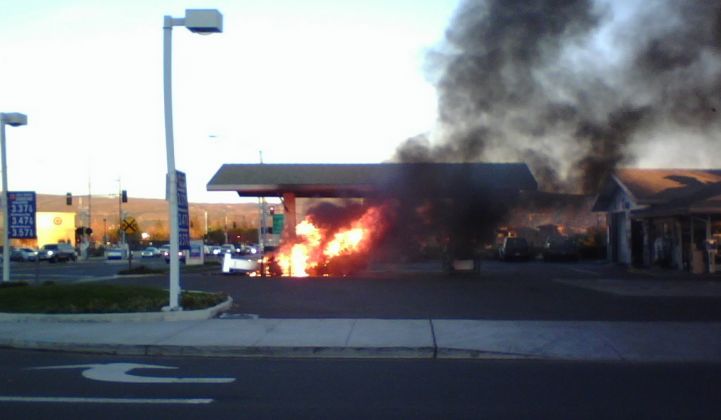Quick math drill: what’s the difference between 15,000 divided by four and 117,000 divided by 5,000?
The answer: it's the difference between the odds your plug-in car will be involved in a fire that may or may not be its fault (one in 3,750), versus the odds of a gas station somewhere in America bursting into flames every year (one in 23).
Let’s take this as a cautionary, if very roughly calculated, statistic before we start talking about the car charger that may or may not have caused a blaze that did $800,000 in property damage to a Mooresville, N.C. home last month.
Duke Energy, the utility testing the car charger, has asked 125 customers to stop using the same brand of charging station for awhile, out of an "abundance of caution,” until it finds out what happened. The lesson is clear: while gas station fires are so common as to escape media attention, a few fires in garages where PHEVs are charging up get tons of media coverage.
Siemens, the maker of the 240-volt fast chargers involved, is investigating the incident. So is General Motors, which has led to speculation that a Chevy Volt may have been the type of plug-in car in the garage. If so, that would make it the second Volt to burn up while plugged in, though the first time that happened, in a Connecticut garage earlier this year, investigators ruled out the car or the charging equipment as the fire’s cause.
We’ve also seen Neil Young’s custom-built plug-in Lincoln Continental (the LincVolt) catch fire and burn down a warehouse full of rock star memorabilia -- and that one appears to have been the car’s fault. In 2008, a Toyota Prius retrofitted for plug-in charging caught fire in Boulder, Colo. after loose electrical wiring lit the upholstery on fire.
So that’s four publicized fires involving plug-in cars -- two of them involving aftermarket retrofits, one ruled out as a cause of the fire, and one still under investigation. In other words, four plug-in fires, out of about 15,000 plug-in vehicles now on U.S. roads, or a rough statistic of one fire for every 3,750 plug-in cars.
While noteworthy, that sounds downright safe compared to the 5,020 fires per year reported in and around gas stations between 2004 and 2008, according to the National Fire Protection Association (PDF). Those fires caused an average of two deaths, 48 fire injuries, and $20 million in direct property damage every year, the association reports -- a toll of death and destruction unmatched in the plug-in car world to date.
According to the U.S. Census Bureau, the country had about 117,000 gasoline stations in 2007. Unless a lot of gas stations are burning up more than once per year, that yields a rate of one gas station in 23 catching fire per year. That’s a pretty scary statistic -- one that it may be unfair to blame entirely on the gas stations themselves -- since 61 percent of those fires started in vehicles. (Doubtless many more were the result of stupid human tricks like smoking cigarettes at the pump or leaving oil-soaked rags lying on garage floors.)
Statistics like these do make car chargers seem a lot safer than gas pumps, don’t they? Sure, some plug-in car equipment has potential for “rare but extreme failure (e.g., arc-flash, catastrophic failure), not only during emergencies but also during regular maintenance,” according to a report from last year’s U.S. National Electric Vehicle Safety Standards Summit. Also, people don’t tend to install gas pumps in their garage, which makes a big difference in the way consumers are likely to feel about the relative risks.
But the main difference between the media covering rare plug-in garage fires and ignoring far more common gas station fires is the novelty of plug-in technology. The same dynamic leads to heightened attention to every incident of a high-tech grid energy storage device blowing up (without injuring anyone, by the way), while oil and gas industry explosions that claim 10 to 20 lives per year (PDF) are just part of the background noise.
There’s nothing wrong with keeping a close eye on new technologies to make sure they’re operating safely in the real world. But the next time you see Fox News claiming that plug-in cars are firetraps because of a few reports of garage fires, remember the odds.



